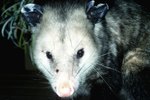
Also known as the common palm civet, the Asian palm civet lives throughout the jungles of Asia. This animal is also called a toddy cat, but it's not a cat. The name comes from the civet’s fondness for palm flower sap, which can be fermented into a liquor used in toddies. A civet is a type of species in the Viverrid family.
Viverridae
The Viverrid family includes 34 species in 20 genera, most of which are nocturnal carnivores. These species as a group are native to Asia, Africa and Europe. Most of them are solitary animals that do not usually associate in large groups. Viverrids are most closely associated with weasels and mongooses, although palm civets are not weasels, either -- they aren't carnivores, consuming mostly fruit.
Physical Appearance
Adult Asian palm civets weigh around 7 pounds and are a little under 2 feet long, with a tail nearly as long as their bodies. These civets have coarse, shaggy gray hair and raccoon-like black facial markings. They also have black fur on their paws and in stripes across their bodies. However, the Asian palm civet doesn't have ringed tails like many other palm civets. The sharp claws on their front and rear paws enable them to climb trees quickly and efficiently.
Habitat & Diet
The Asian palm civet prefers tropical Asian rainforests, but these animals are extremely adaptable and can flourish near human settlements as easily as in dense forests. These nocturnal creatures choose the largest, tallest trees in their habitat to rest in during the day after a night’s foraging. Palm civets are opportunistic omnivores, and although most of their diet is fruit, they also eat insects, eggs and small reptiles. The Asian palm civet in particular enjoys eating coffee cherries, and a luxury coffee made using the beans that pass through the civet’s digestive system sells for more than $100 per pound.
Behavior
Asian palm civets are solitary animals that spend most of their time in trees. They actively forage at night, presumably to avoid predators, and sleep in tall trees during the day. Provided a civet remains in the same area, it will return to the same resting tree several days in a row. Territories may overlap with other civets and are dependent on the availability of resources. The only time civets will share a resting tree with another civet, however, is briefly while mating or when females are caring for their young.
References
Photo Credits
-
Anup Shah/Photodisc/Getty Images
Writer Bio
Jennifer Mueller began writing and editing professionally in 1995, when she became sports editor of her university's newspaper while also writing a bi-monthly general interest column for an independent tourist publication. Mueller holds a Bachelor of Arts in political science from the University of North Carolina at Asheville and a Juris Doctor from Indiana University Maurer School of Law.




